Malted Milk Market Research, 2032
The global malted milk market size was valued at $1.9 billion in 2022, and is projected to reach $3.3 billion by 2032, growing at a CAGR of 5.8% from 2023 to 2032. Malt is a broad category of processed cereals that comes in a variety of market-specific varieties, including malt for brewers and beers which includes both standard and specialty malts), malt for distilling, and malt for culinary uses.
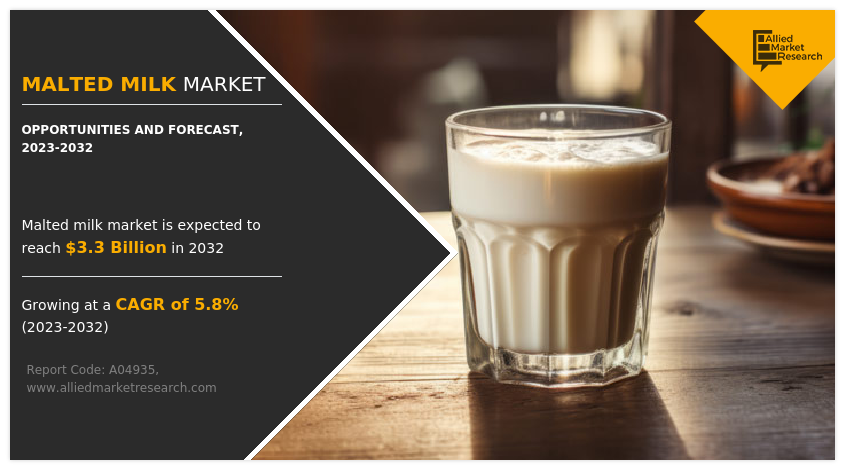
Malted milk is a powdered product made from a combination of malted barley wheat flour and evaporated whole milk. The process of malting involves germinating cereal grains usually barley, and then drying and grinding them into a powder. This malted powder is then blended with wheat flour and milk to create malted milk. The traditional malted milk market refers to the segment of the food and beverage industry that produces and markets malted milk products following classic formulations. This includes powdered malted milk drinks, malted milkshakes, and malted milk-based confectionery. Characterized by a nostalgic appeal, this market often caters to consumers seeking the familiar taste of malted milk beverages reminiscent of the mid-20th century. Wheat, rye, sorghum, and barley cereals work particularly well for this method. The latter is currently the grain that gets malted the most frequently. 90% of the 22 million tons of malt produced in 2015 came from barley. 108 million tons of the 144 million tons of barley produced worldwide in 2017 were used for malting. Barley is a short-season crop, which means one can have a few harvests per year, and it is very adaptable to soil and climate, which are the key factors in its appeal among maltsters.
Malting is about controlled germination of barley grains. It is a natural, biological process that is undertaken using controlled conditions (temperature, humidity, and air). The aim of malting is to begin the conversion of starch into glucose, which is then fermented into alcohol in the brewing process. Malt is made from malting grade cereals, usually barley or wheat, although occasionally other cereals such as rye or oats may be used. The grain is steeped in water, and then allowed to germinate under carefully controlled conditions. When the changes inside the grain are sufficient for the maltsters' requirements, heat is applied in the final stage in the malting process, using a specially designed kiln.
The result, malt, has a moisture content of below 6.5%. The production of 1 ton of malt requires, on average, 1.27 tons of barley, 1.18 Mwh of energy and 5 cubic meters of water. Despite the numerous advantages, it is crucial to remember that malt is still regarded as an added sugar, which can be dangerous if ingested in large quantities. In addition, little is known about how it might affect blood sugar levels. But the primary sugar in malt syrup, maltose, is converted to glucose in the body, and some studies indicate that malt may have a similar impact on blood sugar levels to ordinary sugar.
Malted milk are positioned as nutritious beverages in the market. They are often marketed as containing various nutrients, such as carbohydrate, protein, fats, vitamin A, B, C and E, calcium, iron, phosphorus and potassium. Nonetheless, there is a lack of published literature on malted milk consumption. A study from Singapore indicated that more than 50% of children aged 7 to 10 years consumed malted milk during weekdays and weekends. A recent study from Malaysia demonstrated that combined circuit training with chocolate malt drink supplementation had a significant effect on reducing a bone resorption marker, which imposed positive effect on bone health.
A significant driver propelling the malted milk market growth is the increase in consumer Malted Milk Market Demand for versatile and nutritionally enriched beverages. Malted milk, known for its unique combination of malted barley, wheat flour, and evaporated whole milk, has gained popularity as a wholesome and flavorful option. As health consciousness grows among consumers, malted milk stands out for its inherent nutritional benefits, including essential vitamins and minerals. Moreover, its adaptability in various culinary applications, from traditional malted milkshakes to innovative recipes in the culinary and baking sectors, contributes to its expanding market presence. The versatility of malted milk aligns with contemporary consumer preferences, driving its incorporation into a diverse range of products. This adaptability, coupled with an appreciation for its rich and nostalgic flavor profile, positions malted milk as a dynamic player in the evolving landscape of functional and indulgent beverages.
However, malt has numerous side effects as well. Malt uncommonly induces symptoms of food allergy in sensitized individuals, including Baker's asthma, urticaria, facial itching, Quincke edema, systemic symptoms, and anaphylaxis. Symptoms usually occurred after the consumption of malt-containing chocolate drinks and malt-containing snack products. As per the sources, the global sales of clean-label food products is expected to be valued at $177 billion by 2022. Clean-label trend has been gaining its importance in some of the main sectors of food and beverages industry. Clean label refers to food or beverage products being free from artificial flavors, colors, and preservatives. However, now the category has evolved. Consumers seek to know the origin of the ingredients in their food and beverages products that they consume on daily-basis. Hence food manufacturers and brewers strategize on replacing its artificial or synthetic ingredients with natural or organic ingredients.
Segmental Overview
The malted milk market is segmented on the basis of product type, source, distribution channel, and region. On the basis of product type, the market is bifurcated into powder and liquid. On the basis of source, the market is classified into barley, wheat, and rye. On the basis of distribution channel, the market is categorized into hypermarkets/supermarkets, specialty stores, online sales channels, and Business to business. On the basis of region, the market is analyzed across North America, Europe, Asia-Pacific, and LAMEA.
By Source
On the basis of source the barley segment dominated the global market in 2022. Barley is the most preferred source being used for specialty malt processing. As of 2017, the global barley production accounted to 142.37 million metric tons. Out of which 108 million tons of barley was being used for malt processing. Malting barley is varietal and tastes different depending upon its strain and where it is grown. Barley oriented specialty malt has been gaining higher traction in the craft brewery industry due to its characteristic flavor. Thus, due to some of the key characteristic features possessed by barley coupled with stronghold distribution channel, barley source accounts to higher value Malted Milk Market Share in the global malted milk market.
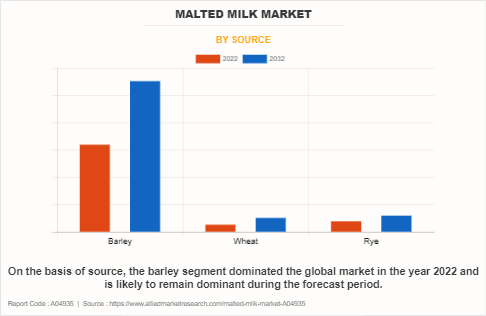
By Product Type
On the basis of product type, the liquid segment dominated the global Malted Milk Industry in 2022 and is likely to remain dominant during the Malted Milk Market Forecast period. Liquid malt form also known as malt syrup is formed from malted barley after cooking it for a certain period. It is an essential ingredient used in making ales and lagers as it gives those beverages taste, color, and body. Liquid malt is available in a variety of colors ranging from light amber to dark amber. Liquid malt comes packed in containers and is intended to be fully utilized once the containers are open. The liquid malt segment is driven by increase in consumption of beer worldwide, which is supplemented by rise in cross cultural interaction among people and increase in disposable income of people worldwide.
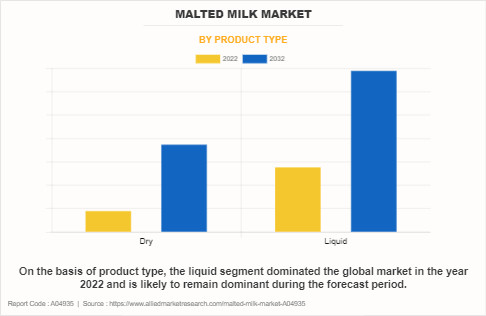
By Distribution Channel
On the basis of distribution channel, the business-to-business segment dominated the global market in 2022. On the basis of region, North America dominated the global market in 2022. U.S. was the most prominent market in the region with maximum share and a notable CAGR of 4.1%. North America is a mature market with high adoption of malt-based products. The players operating in the global malted milk market have adopted various developmental strategies to increase their market share, gain profitability, and remain competitive in the market. The report offers a thorough analysis of malted milk market with detailed study of various aspects of the market such as market dynamics, vital segments, major geographies, key players, and competitive landscape. The report provides a clear picture of the current market situation and future trends of the malted milk market based on the impact of various market dynamics and vital forces influencing the market. The drivers and opportunities in the market contributing to the market growth are acknowledged in the market dynamics.
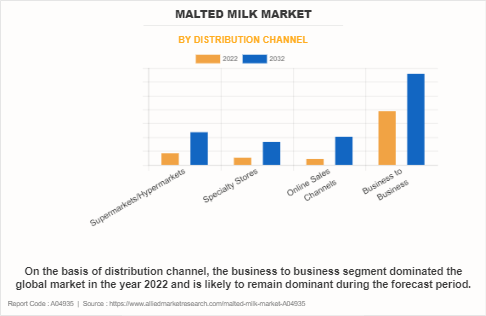
By Region
Besides, challenges and restraints that hold potential to hamper the market growth are also premeditated in the malted milk market. Porter's five forces analysis is delivered through the report which precisely highlights the effects of key forces on the malted milk market. The report offers market size and estimations analyzing malted milk market through various segments. In addition, the report includes geographical market analysis of these segments. Each segment entailed in the report is studied at regional and country level as well to provide complete coverage of malted milk market. The report analyzes the malted milk market across four major geographies including North America, Europe, Asia-Pacific, and LAMEA. These geographies are further sub-categorized into countries to cover malted milk market scenario across in respective regions. Furthermore, the report covers competitive scenario of the malted milk market. The key players operating in the malted milk market are studied in the report to understand their current market position and competitive strengths in the industry.
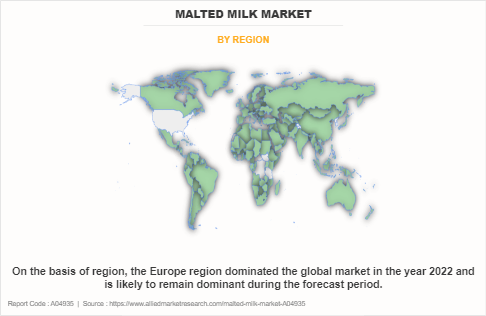
Competition Analysis
The key player included in the malted milk market analsysis are Nestle S.A., The Hain Celestial Group, Inc., Associated British Foods PLC, Reckitt Benckiser Group PLC, Malt Products Corporation, King Arthur Baking Company, Inc., PMV Malting, Unilever PLC, Imperial Malts Ltd., Gujarat Cooperative Milk Marketing Federation Ltd.
Key Benefits for Stakeholders
- This report provides a quantitative analysis of the market segments, current trends, estimations, and dynamics of the malted milk market analysis from 2022 to 2032 to identify the prevailing malted milk market opportunities.
- The market research is offered along with information related to key drivers, restraints, and opportunities.
- Porter's five forces analysis highlights the potency of buyers and suppliers to enable stakeholders make profit-oriented business decisions and strengthen their supplier-buyer network.
- In-depth analysis of the malted milk market segmentation assists to determine the prevailing market opportunities.
- Major countries in each region are mapped according to their revenue contribution to the global market.
- Market player positioning facilitates benchmarking and provides a clear understanding of the present position of the market players.
- The report includes the analysis of the regional as well as global malted milk market trends, key players, market segments, application areas, and market growth strategies.
Malted Milk Market Report Highlights
| Aspects | Details |
| Market Size By 2032 | USD 3.3 billion |
| Growth Rate | CAGR of 5.8% |
| Forecast period | 2022 - 2032 |
| Report Pages | 300 |
| By Source |
|
| By Product Type |
|
| By Distribution Channel |
|
| By Region |
|
| Key Market Players | Imperial Malts Ltd., Malt Products Corporation, The Hain Celestial Group, Inc., PMV Malting, Reckitt Benckiser Group PLC, King Arthur Baking Company, Inc., Associated British Foods PLC, Gujarat Cooperative Milk Marketing Federation Ltd., Unilever PLC, Nestle S.A. |
Analyst Review
According to the insights of the CXOs of leading companies, some of the key functional properties possessed by malted milk, is one of the key factors in driving the demand for the product. These properties include a unique suite and toasty flavor, solubility, aroma enhancement, texture improvement, colour enhancement, nutrient enrichment, caramelization attributes, and binding capabilities, which play a crucial role in shaping the market dynamics.With the rise in health and wellness trend among the consumers, some of the key food and beverages manufacturers have been strategizing on replacing artificial or synthetic ingredients with natural ingredients for processing. This trend has paved the way for the growth of the global malted milk market in terms of value sales.The CXO acknowledges the importance of balancing heritage with innovation. There is a keen awareness that while the traditional malted milk market provides a stable foundation, tapping into emerging trends is crucial. This includes a focus on health-conscious formulations, incorporating functional ingredients to meet the demands of a wellness-driven market.Moreover, the CXO sees opportunities in the artisanal or craft malted milk segment. This perspective involves viewing malted milk not just as a product but as an experience. Crafting unique blends, experimenting with limited editions, and embracing premium positioning are seen as avenues to capture the attention of discerning consumers seeking a more exclusive malted milk offering.
The global malted milk market size was valued at $1.9 billion in 2022, and is projected to reach $3.3 billion by 2032
The global Malted Milk market is projected to grow at a compound annual growth rate of 5.8% from 2023 to 2032 $3.3 billion by 2032
The key player included in the malted milk market analsysis are Nestle S.A., The Hain Celestial Group, Inc., Associated British Foods PLC, Reckitt Benckiser Group PLC, Malt Products Corporation, King Arthur Baking Company, Inc., PMV Malting, Unilever PLC, Imperial Malts Ltd., Gujarat Cooperative Milk Marketing Federation Ltd.
The Europe region held the highest market share in 2022, accounting for nearly half of the global malted milk market revenue and is estimated to maintain its leadership status throughout the forecast period.
Comprise of numerous health benefits, Large scale application of malt in food industry
Loading Table Of Content...
Loading Research Methodology...



